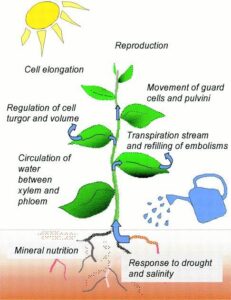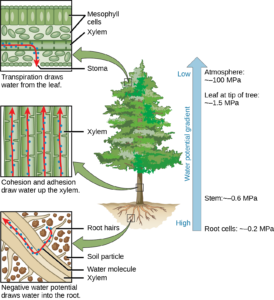Back to: Botany 300 Level
Hello, my brilliant Afrilearn scholar! I hope you’re doing well today! Have you ever wondered how plants drink water even though they don’t have mouths? Or why leaves sometimes look fresh and full of life, while at other times, they wilt and droop? The secret is in the relationship between plants and water! Today, we will break it down in a way that’s simple, practical, and relatable.
Plant-water relationships (transpiration, water potential, osmosis)
How Do Plants Use Water?
Water is life—not just for humans but for plants too! Plants need water to grow, make food, and stay healthy. But how do they take in water, move it around, and sometimes lose it? Let’s look at three important processes: osmosis, water potential, and transpiration.

1. Osmosis: How Plants Absorb Water
Osmosis is a big word, but it’s really simple! It is the process by which water moves from the soil into plant roots. Imagine soaking a dry sponge in water—it absorbs water automatically, right? That’s exactly how plant roots take in water from the soil!
Roots have tiny hairs called root hairs that absorb water from the soil.
The water moves into the root cells because of osmosis, where water moves from a region of more water (wet soil) to a region of less water (inside the plant).
This water then moves up the plant to the leaves, where it is used for photosynthesis.
2. Water Potential: Why Water Moves in a Plant
Now, why does water keep moving from the roots to the stem and then to the leaves? This happens because of water potential—a fancy way of saying that water moves from areas where there is more of it to areas where there is less.
The soil has the highest water potential because it is full of water.
The roots have less water than the soil, so water moves into them.
The stem has even less water, so water keeps moving upwards.
The leaves have the lowest water because they lose water to the air, so water keeps moving up to replace it.

This continuous movement of water through the plant is called the transpiration stream.
3. Transpiration: How Plants Lose Water
Now, let’s talk about transpiration—the process by which plants lose water from their leaves into the air. If you’ve ever noticed water droplets on a leaf early in the morning or seen a plant drying up on a hot afternoon, you’ve witnessed transpiration!
Water evaporates from tiny holes in leaves called stomata.
This helps cool the plant, just like sweat cools our bodies when we are hot.
It also helps pull more water up from the roots, keeping the plant hydrated.
However, too much transpiration can be bad because the plant may lose more water than it takes in, causing it to wilt. That’s why plants close their stomata during hot weather to prevent excessive water loss.
Summary
Plants absorb water through their roots by osmosis, move it upwards using water potential, and lose excess water through transpiration. These processes help plants stay hydrated, transport nutrients, and regulate temperature. However, if a plant loses too much water, it can wilt or die.
Evaluation
- What is osmosis, and how does it help plants?
- Explain the concept of water potential in plants.
- What is transpiration, and why is it important?
- How do plants reduce excessive water loss?
You are doing great! Keep learning, and soon, you’ll understand how plants survive in different environments. Who knows? One day, you might use this knowledge to improve agriculture in Nigeria! Keep growing with Afrilearn, and see you in the next lesson!
